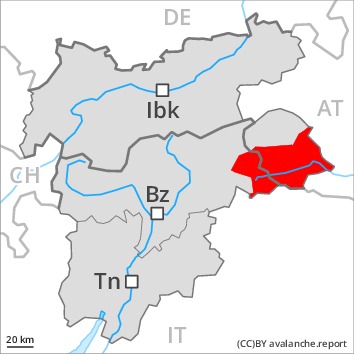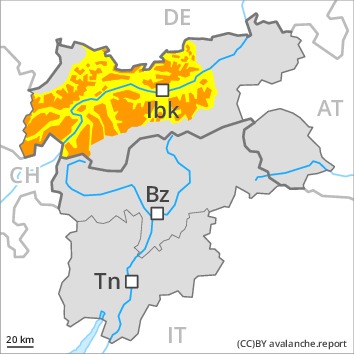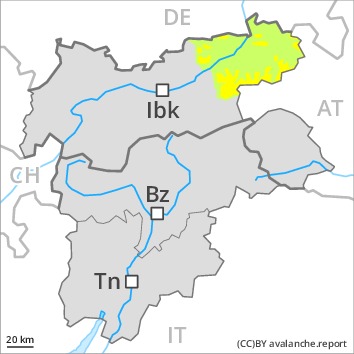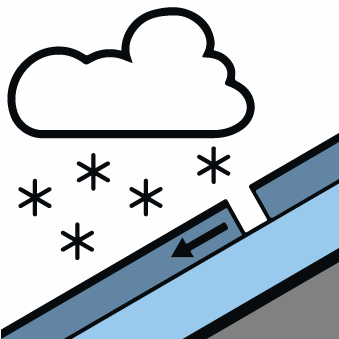
Danger level
 | 2600m
|
Avalanche Problem

In particular on steep grassy slopes natural avalanches must be expected more frequently. New snow and wind slabs are to be critically assessed.
On steep grassy slopes gliding avalanches are possible at any time, even very large ones in isolated cases. This applies in all aspects below approximately 2600 m. Exposed parts of transportation routes can be endangered.
The new snow and wind slabs are prone to triggering in all aspects above the tree line. The number and size of avalanche prone locations will increase with altitude. From origins in starting zones at higher altitudes individual natural dry avalanches are possible.
The current avalanche situation calls for very extensive experience in the assessment of avalanche danger and great restraint.
Snowpack
dp.2: gliding snow
dp.6: cold, loose snow and wind
15 to 30 cm of snow, and even more in some localities, will fall on Wednesday. The strong wind has transported the new snow significantly. In some cases the various wind slabs have bonded poorly together. This applies at high altitudes and in high Alpine regions. The no longer entirely fresh wind slabs are covered with new snow and therefore difficult to recognise.
Tendency
The avalanche danger will decrease gradually. Caution is to be exercised in areas with glide cracks.

Danger level
 | 2600m
|
Avalanche Problem
 | | Gliding snow |
|  | |  |
 | | Wind-drifted snow |
|  | |  |

In particular on steep grassy slopes natural avalanches must be expected more frequently. Fresh wind slabs are to be evaluated critically.
On steep grassy slopes gliding avalanches are possible at any time, even very large ones in isolated cases. This applies in all aspects below approximately 2600 m. Exposed parts of transportation routes can be endangered.
The fresh wind slabs are to be evaluated with care and prudence in all aspects above the tree line. The number and size of avalanche prone locations will increase with altitude. From origins in starting zones at higher altitudes only isolated natural dry avalanches are possible.
The current avalanche situation calls for very extensive experience in the assessment of avalanche danger and great restraint.
Snowpack
dp.2: gliding snow
dp.6: cold, loose snow and wind
5 to 10 cm of snow, and up to 15 cm in some localities, will fall on Wednesday. The strong wind has transported the new snow significantly. In some cases the various wind slabs have bonded poorly together. This applies at high altitudes and in high Alpine regions. The no longer entirely fresh wind slabs are covered with new snow and therefore difficult to recognise.
Tendency
The avalanche danger will decrease gradually. Caution is to be exercised in areas with glide cracks.

Danger level
 | treeline
|
Avalanche Problem
 | | Wind-drifted snow |
|  | |  |
 | | Persistent weak layer |
|  | |  |

Wind slabs and weakly bonded old snow represent the main danger.
Weak layers in the old snowpack can be released by individual winter sport participants, caution is to be exercised in particular on steep shady slopes above the tree line, as well as on steep sunny slopes above approximately 2500 m, especially at transitions from a shallow to a deep snowpack, as well as in areas where the snow cover is rather shallow. Avalanches can in some cases reach large size.
In addition the fresh wind slabs should be taken into account, in particular adjacent to ridgelines and in gullies and bowls above the tree line. The number and size of avalanche prone locations will increase with altitude.
On steep grassy slopes gliding avalanches are to be expected, even large ones in isolated cases, especially on very steep sunny slopes below approximately 2600 m.
The current avalanche situation calls for defensive route selection.
Snowpack
dp.1: deep persistent weak layer
dp.6: cold, loose snow and wind
5 to 10 cm of snow will fall. As a consequence of a moderate to strong southeasterly wind, avalanche prone wind slabs will form in particular above the tree line. The no longer entirely fresh wind slabs are covered with new snow in some cases and therefore difficult to recognise. The old snowpack will be weakly bonded in some places. Whumpfing sounds and the formation of shooting cracks when stepping on the snowpack indicate the unfavourable bonding of the snowpack.
Tendency
The avalanche danger will persist.

Danger level
 | treeline
|
Avalanche Problem
 | | Persistent weak layer |
|  | |  |
 | | Wind-drifted snow |
|  | |  |

Wind slabs and weakly bonded old snow represent the main danger.
Weak layers in the old snowpack can be released by individual winter sport participants, caution is to be exercised in particular on steep shady slopes above the tree line, as well as on steep sunny slopes above approximately 2500 m. Mostly avalanches are medium-sized.
In addition the fresh wind slabs should be taken into account, in particular adjacent to ridgelines and in gullies and bowls above the tree line. The number and size of avalanche prone locations will increase with altitude.
On steep grassy slopes gliding avalanches are possible, in particular medium-sized ones, especially on very steep sunny slopes below approximately 2600 m.
The current avalanche situation calls for experience in the assessment of avalanche danger and careful route selection.
Snowpack
dp.1: deep persistent weak layer
dp.6: cold, loose snow and wind
5 to 10 cm of snow will fall. As a consequence of a moderate to strong southeasterly wind, avalanche prone wind slabs will form in particular above the tree line. The old snowpack will be weakly bonded in some places. Whumpfing sounds and the formation of shooting cracks when stepping on the snowpack indicate the unfavourable bonding of the snowpack.
Tendency
The avalanche danger will persist.

Danger level
 | 2000m
|
Avalanche Problem

Fresh wind slabs are to be evaluated with care and prudence.
The fresh and older wind slabs represent the main danger. They can be released by a single winter sport participant in some cases in particular on northwest to north to northeast facing aspects at high altitude. They are mostly small. They are clearly recognisable to the trained eye.
Snowpack
dp.6: cold, loose snow and wind
5 to 10 cm of snow will fall. The southeasterly wind will transport the new snow. The old snowpack is weak in some cases, especially on steep shady slopes at high altitude. At low and intermediate altitudes hardly any snow is lying.
Tendency
The avalanche danger will persist.

Danger level
 | 2000m
|
Avalanche Problem

Fresh wind slabs are to be evaluated with care and prudence.
The fresh and older wind slabs represent the main danger. They can be released by a single winter sport participant in some cases in particular on northwest to north to northeast facing aspects at high altitude. They are mostly small. They are clearly recognisable to the trained eye.
Snowpack
dp.6: cold, loose snow and wind
5 to 10 cm of snow will fall. The southeasterly wind will transport the new snow. The old snowpack is weak in some cases, especially on steep shady slopes at high altitude. At low and intermediate altitudes hardly any snow is lying.
Tendency
The avalanche danger will persist.





















